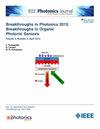低复杂度自适应均衡器低分辨率相干光通信系统性能研究
IF 2.4
4区 工程技术
Q3 ENGINEERING, ELECTRICAL & ELECTRONIC
引用次数: 0
摘要
相干光通信系统是现代高速数据传输的重要组成部分。然而,这些系统面临着高成本和复杂性的挑战,特别是在短距离相干光通信系统中。为了解决这些问题,我们提出了一种具有低复杂度自适应均衡器的低分辨率相干光通信系统。系统的性能在5公里28 GBaud 16 QAM传输场景中进行评估。仿真结果表明,误差反馈噪声整形(EFNS)能有效抑制数模转换器(DAC)的量化噪声,从而降低对DAC的分辨率要求。此外,基于stokes域去极化方案(SS-AEQ)的自适应均衡器将均衡算法的复杂度降低了45%。与8位分辨率DAC和传统的2 × 2 MIMO AEQ方案相比,该系统采用4位DAC进行低分辨率传输,在保持相当传输性能的同时实现了低复杂度均衡。本文章由计算机程序翻译,如有差异,请以英文原文为准。
Performance Investigation of Low-Resolution Coherent Optical Communication System with Low-Complexity Adaptive Equalizer
Coherent optical communication systems are essential for modern high-speed data transmission. However, these systems face challenges related to high cost and complexity, especially in short-reach coherent optical communication systems. To address these issues, we present a low-resolution coherent optical communication system with low-complexity adaptive equalizer. The system's performance is evaluated in a 5 km 28 GBaud 16 QAM transmission scenario. The simulation results indicate that error-feedback noise shaping (EFNS) is highly effective in suppressing digital-to-analog converter (DAC) quantization noise, thereby reducing resolution demands on the DAC. Furthermore, the adaptive equalizer, based on a Stokes-domain depolarization scheme (SS-AEQ), achieves a 45% reduction in the complexity of the equalization algorithm. Compared with the 8-bit resolution DAC and the traditional 2 × 2 MIMO AEQ scheme, the system, employing 4-bit DAC for low-resolution transmission, achieves low-complexity equalization while maintaining comparable transmission performance.
求助全文
通过发布文献求助,成功后即可免费获取论文全文。
去求助
来源期刊

IEEE Photonics Journal
ENGINEERING, ELECTRICAL & ELECTRONIC-OPTICS
CiteScore
4.50
自引率
8.30%
发文量
489
审稿时长
1.4 months
期刊介绍:
Breakthroughs in the generation of light and in its control and utilization have given rise to the field of Photonics, a rapidly expanding area of science and technology with major technological and economic impact. Photonics integrates quantum electronics and optics to accelerate progress in the generation of novel photon sources and in their utilization in emerging applications at the micro and nano scales spanning from the far-infrared/THz to the x-ray region of the electromagnetic spectrum. IEEE Photonics Journal is an online-only journal dedicated to the rapid disclosure of top-quality peer-reviewed research at the forefront of all areas of photonics. Contributions addressing issues ranging from fundamental understanding to emerging technologies and applications are within the scope of the Journal. The Journal includes topics in: Photon sources from far infrared to X-rays, Photonics materials and engineered photonic structures, Integrated optics and optoelectronic, Ultrafast, attosecond, high field and short wavelength photonics, Biophotonics, including DNA photonics, Nanophotonics, Magnetophotonics, Fundamentals of light propagation and interaction; nonlinear effects, Optical data storage, Fiber optics and optical communications devices, systems, and technologies, Micro Opto Electro Mechanical Systems (MOEMS), Microwave photonics, Optical Sensors.
 求助内容:
求助内容: 应助结果提醒方式:
应助结果提醒方式:


